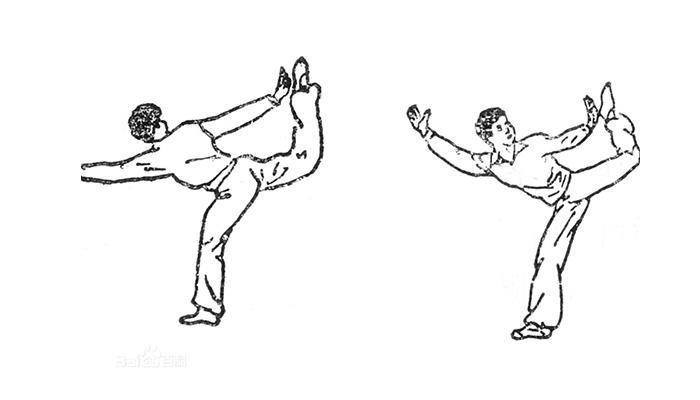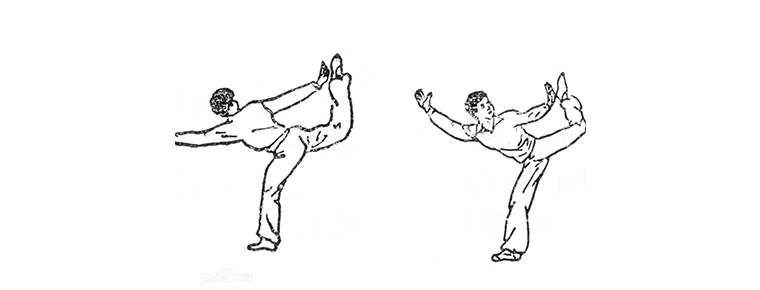Poke feet
Poke feet
Poking feet is one of Chinese boxing. Leg and foot kungfu is the main form. It is said that it originated in the Song Dynasty and flourished in the Ming and Qing Dynasties. The story of Wu Song's drunken beating Jiang Menshen in Chinese folklore tells us that Wu Song used the jade ring step and the Mandarin duck's feet to poke his feet. Therefore, some people still call poking his feet "Shuihumen".
On November 11, 2014, the stamp was approved by the State Council to be included in the fourth batch of national intangible cultural heritage list.
Basic introduction
Punching the foot is a kind of boxing in the north, which is mainly based on leg and foot kungfu. It is said that it originated in the Song Dynasty and is known as "the outstanding person in the North leg". Wu Song beat Jiang Menshen drunkenly. Wu Song used the Yuhuanbu step and the mandarin duck foot. Legend has it that during the Taiping Heavenly Kingdom, Zhao Canyi, a Taiping Army general, was proficient in poking feet and turning boxers. After the defeat of the Taiping Army in Tianjin, Zhao Canyi lived in seclusion in Raoyang, Hebei Province, and handed down poking and turning boxing to the local people. The main legs are kicking, lifting, drifting, dotting and seeing the end. It also emphasizes the skill of both hands and feet. The boxing proverb says, "Hands are two doors, and they hit people with their legs." "Hands hit three points, and feet kick seven points". In the body law, it is required to be correct, flexible, dominant in the waist, and the shoulder and hip of the guest and assistant. From the spine to the foot and from the hip to the hip, they both use the waist gap and shoulder crotch, and often cooperate with the ground movement. There are "eight roots" and "nine branches" in boxing. "Eight roots" multi-lower cross-legged method and "nine branches" multi-upper cross-legged method. One step one leg, one step one foot, a series of kicks, hands and feet.
There are two kinds of trips, one is to poke feet, the other is to poke feet, and the other is to poke feet. The martial arts are flexible, vigorous, long-term, rigid and flexible, mainly rigid. In the comprehensive exercise of hands, eyes, hearts, bodies and steps, the focus is on leg and footwork. The basic leg methods include picking, shearing, dicing, turning, facing the door, inserting and blocking, right and left legs (finger, kicking, turning, point, webbed, wrong, pedaling, rolling, etc.). The traditional Wulu routine is also called "Nine-turn Linked Mandarin Duck Feet", short for "Nine-branch Legs", a total of nine routes, each of which can be exchanged for practice, so it is called "Nine-turn". Each leg method is one step at a time, issued in succession, and the rings are set together, so it is called "Link". Its legs and feet are attacked in succession, left and right sides are exchanged, forming a pair of spouses, so it is called "Mandarin Duck Foot". Wen watches are vigorous and soft, with stitches hidden in them, small and compact, flexible and changeable, close to the shadow, and soft with stiffness. The traditional literary routines are called "Eight Roots" (self-turning feet, Yuhuanbu, stone thunder, archer-like, webbed legs, going out, firecrackers, cross-beating, etc.). Literary routines are lively and rhythmic, and their training methods are mind-to-mind, hand-to-foot; their techniques are push, lift, cotton, turn, paste, Sichuan, entanglement and development; their footwork is forward, backward, flash, swing, pumping, change, channeling, swing; their tactics are one step at a time, unexpected, luring the enemy into depth, then restraining, lower limbs start, half-step wins, like kicking non-kicking, striking in the East and striking in the west. There is also a kind of foot-poking in Northeast China, which is created by Hu Feng-san because of its unique legs and strong fighting ability. With the basic usage of eight roots, eight mothers, eight methods and sixteen formulas and thirty-two characters as the core, the combination of rigidity and softness, short and concise, compact upper body, lower body life, lingering techniques, strong legs, close to combat, flexible and changeable, also known as "Hu's foot poking", Hu's foot poking is mainly "Wen trip", while practicing "Wu trip".
Style and characteristics
To stamp a footnote,
There are two kinds of Wu trips, Wu trips are the origin of poking feet, Wen trips are the development and change of Wu trips. The characteristics of Wu Tuzi are: stretching generously, agility and vigor, long-term striking, rigidity and flexibility, mainly rigidity; it is in the comprehensive exercise of hands, eyes, heart, body and steps, focusing on the exercise of leg and footwork. The basic leg kicking methods include picking, shearing, dicing, turning, blocking in front of the door, right and left legs (fingering, kicking, turning, pointing, webbing, wrong, pedaling, grinding, etc.). The traditional Wulu routine is also called "Nine-turn Linked Mandarin Ducks'Feet". It is abbreviated as "Nine-branch Legs". There are nine routes, each of which can exchange exercises with each other, so it is called "Nine-turn". Each leg method is a step-by-step, continuous, ring-by-ring, so it is called "Link". Its legs and feet are attacked in succession, switching left and right, forming a pair of spouses, thus poking feet.
It is called "mandarin duck foot". Wen watches are vigorous and soft, with stitches hidden in them, small and compact, flexible and changeable, close to the shadow, and soft with stiffness. The traditional literary routines are called "Eight Roots" (self-turning feet, Yuhuanbu, stone thunder, archer-like, webbed legs, going out, firecrackers, cross-beating, etc.). Literary routines are lively and rhythmic, and their training methods are mind-to-mind, hand-to-foot; their techniques are push, lift, cotton, turn, paste, Sichuan, entanglement and development; their footwork is forward, backward, flash, swing, pumping, change, channeling, swing; their tactics are one step at a time, unexpected, luring the enemy into depth, then restraining, lower limbs start, half-step wins, like kicking non-kicking, striking in the East and striking in the west. Pointing feet is good for legs, but it emphasizes the use of hands and feet. The proverb of boxing says, "The hand is two doors, and it hits people by the leg", "The hand hits three points, the foot kicks seven points". It also says, "If the upper limb is not enough, the legs are not good", "If the hand does not reach the leg, it is pure nonsense". Pointing feet in the body law requires centrality, flexibility, dominant in the waist, Binfu shoulder crotch. Start from the spine, start from the buttocks, both of them with waist gap shoulder crotch, that is, the so-called "art preparation method is high, skill to invisible first surprise". After the founding of the People's Republic of China, foot poking was listed as a national Wushu performance and competition item.
historical origin
It is a northern boxing. According to legend, Zhao Yican, the Taiping Army general, left the fist in Raoyang, Hebei Province, when he lived in seclusion. Punching feet is a kind of boxing which is gradually enriched and perfected on the basis of eight diamond frames, eight diamond beats and "Yuhuanbu" techniques. Because they are good at legs, they are praised as the "outstanding northern legs" by later generations.
The full name of "Jiufan imperial step mandarin ducks hang in a series of suspended poking feet". This fist is penny-for-penny and martial arts trip. Its routine changes are evolved from eight basic potentials. "Jiufan" means that there are nine ways for Wen and Wu to travel, and "imperial step" is a typical footwork for poking feet, while "hooking up and linking up" means that all forces are attacked or defended, linked and connected. Pointing feet often take false steps to stand, move hand and foot together, and force feet hanging, so it is known as "suspension", and when attacking, left and right exchange, into a pair of spouses and alias "duck feet". Later generations took "martial Arts trip" as leg work, and took turning boxing as the main body to melt into a furnace and formed "poking foot turning over".
Distribution: Mainly spread in Hebei, Tianjin, Beijing, Northeast China and other places, there are also practitioners in the south.


-
1.Mianzhu New Year Picture Village Scenic Area in China
New Year Picture Village is located in Xiaode Town, South Gate of Mianzhu City, Sichuan Province. It is located between De'a Highway and Chengqing Highway, 73 kilometers away from Chengdu and within o
Time 2018-12-22 -
2.Jiaozuo Film and Television City
Jiaozuo Film and Television City, located in Jiaozuo City, Henan Province, is a large-scale comprehensive tourist area with film and television shooting services as the main function
Time 2019-01-22 -
3.Longyu Bay National Forest Park
Longyuwan National Forest Park is located in Luanchuan County, Henan Province. It is 165 kilometers away from Luoyang City. It covers an area of 1833 hectares
Time 2019-02-06 -
4.Ziweidong Scenic Area
Seeing the pronoun of the first reaction of "purple cave" to "immortal" cultivation and residence, we often enchase that fairyland dream on this name.
Time 2019-03-22 -
5.Tibetan Engraving and Printing Skills of Dege School of Printing
Tibetan engraving and printing skills of Dege Printing Institute, local traditional handicraft skills of Dege County, Sichuan Province, and one of the national intangible cultural heritages.
Time 2019-04-26 -
6.Foshan Wood Engraving New Year Pictures
Foshan woodcut New Year's picture is a famous folk New Year's picture in South China and a wonderful flower of Lingnan traditional folk culture. It is as famous as the New Year
Time 2019-04-29 -
7.Restoration Techniques of Ancient Ceramics
Ancient ceramic restoration technology is a special artistic creation of comprehensive modeling, sculpture, color, calligraphy, painting, chemical industry, etc. Ancient Ceramics Restoration must be c
Time 2019-05-01 -
8.Jiangnan bamboo
Chinese traditional instrumental music, silk and bamboo, is popular in southern Jiangsu and Zhejiang. After the Revolution of 1911, great progress was made in Shanghai
Time 2019-05-05 -
9.Ancient dance Lao Gu dance
Ancient dance, the meaning of "breaking through the barrier" in Li language, is called "ancestor-telling" in ancient books. The ancestor worship originated from the primitive socie
Time 2019-05-11 -
10.Yangzhou Tanci
Yangzhou's performance of ci-poems is mainly based on speech and supplemented by singing and playing. The representative bibliographies are "Double Gold Ingot", "Pearl Tower", &quo
Time 2019-07-10 -
11.Seven Star Mountain tower
The Seven Star Mountain tower, commonly known as the black tower, was built in the Jiajing period of the Ming Dynasty (1522-1566). It is the brother tower of Dongshan white tower. It is on a peak of Qixing mountain in Taba village, Nanguang Town
Time 2020-10-16 -
12.Four famous Chinese embroidery
Suzhou embroidery is famous for its fine stitches, elegant colors and fine embroidery. It has the characteristics of flat, light, even, harmonious, fine and dense. The theme is mainly about small animals. Such as "cat play", "wind through flowers",
Time 2020-12-12